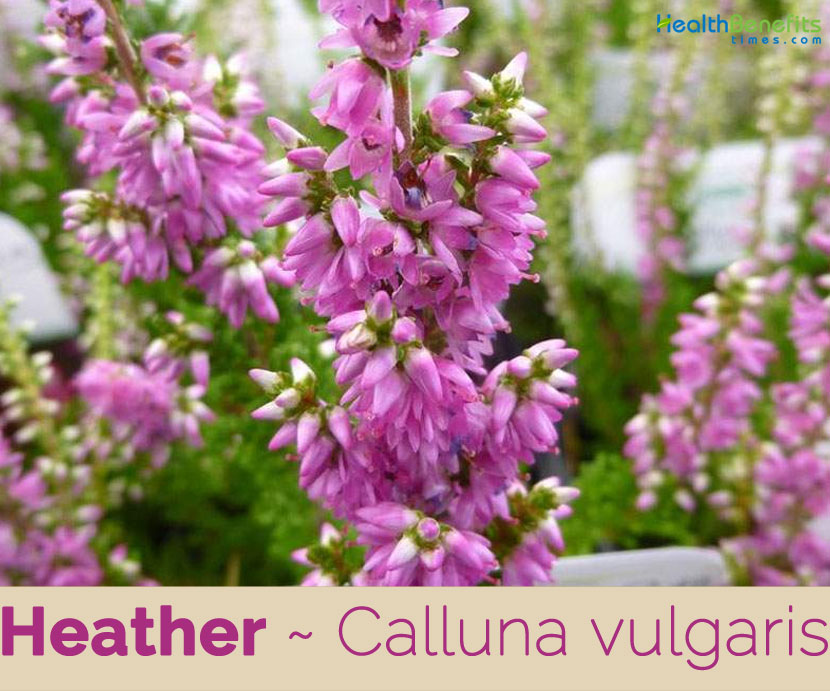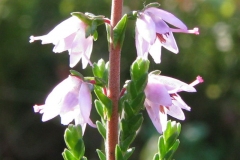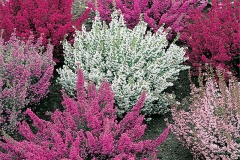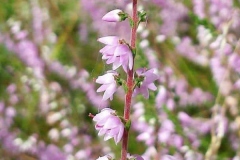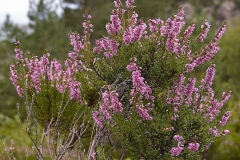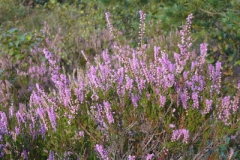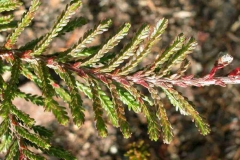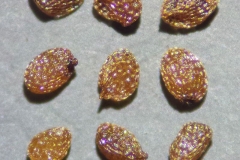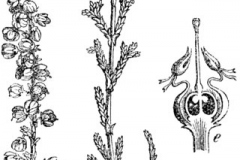Heather Facts
| Heather Quick Facts | |
|---|---|
| Name: | Heather |
| Scientific Name: | Calluna vulgaris |
| Origin | Africa, temperate Asia and Europe and is an invasive weed in Australia, the United States, Canada and New Zealand |
| Colors | Yellowish to orange |
| Shapes | Small, spherical, capsules that are 2-2.5 mm wide and are densely covered in hairs and remain hidden inside the petals |
| Taste | Bitter, sweet, astringent |
| Health benefits | Beneficial for coughs, colds, bladder and kidney disorders, cystitis, rheumatism, arthritis, gout, insomnia, menstrual discomfort, menopause, nervous exhaustion and wounds |
| Name | Heather |
|---|---|
| Scientific Name | Calluna vulgaris |
| Native | Africa, temperate Asia and Europe and is an invasive weed in Australia, the United States, Canada and New Zealand |
| Common Names | Biercol, heather, ling, red-heath, Scotch heather, Scots heather, sand heather, woolly hudsonia, false heather, woolly beach heather |
| Name in Other Languages | Afrikaans: Heather, Blouklokkies Albanian: Shqopë, brushtulli Arabic: خلنج نبات [khalinaj naba’at], hashayshat almukanasa (حشيشة المكنسة) Armenian: Ts’akhi (ցախի), havamrgi (հավամրգի) Azerbaijani: Funda Bashkir: Yabay arsa (Ябай арса) Basque: Txilar, Ainar arrunt, txilarra Belarusian: Vieras (верас) Bengali: Gulmabiśēṣa (গুল্মবিশেষ) Bokmal: Røsslyng Bosnian: Vrijesak Bulgarian: Piren (пирен), obiknovena kaluna (обикновена калуна) Catalan: Bruc, Bruguerola, Brossa, sap, brinzes, bronsa, brossa, bruga, brussa, bruza, carrasella, cepell, cipell, herba negra, xipell Cebuano: Heather Chichewa: Heather Chinese: Shí nán shǔ (石南属) Croatian: Vrijesak, Vrijes, obični vrijes Czech: Vřes, vřes obecný Danish: Lyng, Hedelyng, Gemeen lyng, Liung, Dutch: Heide, Struikhei, struikheide English: Scotch heather, Scots heather, Heather, ling, Red-heath, Scottish: heather, Red heather, Bellflowers, Calluna, Esperanto: Eriko, Kaluno Estonian: Kanarbik Faroese: Vanligur heiðalyngur Filipino: Heather Finnish: Kanerva French: Bruyère , Callune, Bruyère commune, brande, breuvée, bucane, béruée, callune fausse-bruyère , fausse bruyère , grosse brande , péterolle Galician: Urce, Queiroa Georgian: Heather German: Heidekraut, Besenheide, Besenkraut, Heidekraut, Sandheide Greek: Ereíki (ερείκη) Gujarati: Kharāba kē vērāna bhūminē kāṇṭāḷāṁ jhāḍavānī anēka jātō paikīnī harakō’ī ēka (ખરાબા કે વેરાન ભૂમિનાં કાંટાળાં ઝાડવાંની અનેક જાતો પૈકીની હરકોઈ એક) Haitian Creole: Heather Hausa: Heather Hebrew: Abrsh (אַברָשׁ) Hindi: Heeth (हीथ) Hmong: Heather Hungarian: Hanga, csarab Icelandic: Heather, Beitilyng Igbo: Heather Indonesian: Heather Irish: Fraoch Italian: Erica, Brentoli, Brughiera, Brugo, Grecchia, Scopetti, Sorcelli, brughiera commune, calluna, Japanese: Hezā (ヘザー), Karūna zoku (カルーナ属) Javanese: Heather Kannada: Hider (ಹೀದರ್) Kazakh: Хизер, Kökbuta (Көкбұта) Khmer: Hi theu r ban (ហ៊ីធើរបាន) Korean: Hiseu (히스) Lao: Heather Latin: Erica Latvian: Virši, Sila virsis, parastais virsis Lithuanian: Silojas, Šilinis viržis Livvi: Kanabro Macedonian: Heder (Хедер) Malagasy: Heather Malay: Heather Malayalam: Heather, kālūṇa (കാലൂണ) Maltese: Heather Maori: Heather Marathi: Sadāharita jhuḍūpa yālā phikkaṭa jāmbhaḷī kinvā pāṇḍharī phulē yētāta (सदाहरित झुडूप याला फिक्कट जांभळी किंवा पांढरी फुले येतात) Mongolian: Emma (Эмма) Myanmar (Burmese): Heather Nepali: Heather Northern Sami: Livdnju Norwegian: Lyng, Jamnes söster, Bulyng, Gemeen lyng, Liung, Roslyng, Røsbær-lyng, Røskie-lyng Occitan: Brousso, Bruc Ossetian: Мыдæг Persian: خلنگ زار, علف جاروب Polish: Wrzos, wrzos zwyczajny Portuguese: Urze, Torga-ordinária, leiva, mongariça, queiroga, queiró-das-ilhas, rapa, torga-ordinária, urze, urze-roxa Romanian: Buruiană, mărtăloagă Romansh: Brutg, iarbă-neagră Russian: Veresk (вереск), veresk obyknovennyy (вереск обыкновенный ) Serbian: врес [vres], obychnyy ves (обични врес) Sesotho: Heather Shambala: Vrijes Sinhala: Hedar (හෙදර්) Slovak: Vres, vres metlovitý, vres obyčajný, Slovenian: Heather, jesenska vresa Somali: Heather Spanish: Brezo, Biercol, Leiva, Queiró, Rapa, brecina, Ljung, argana, brezo comun, bruga, bruza, gorbeza, berozo, biércol merino, brecina, brecinilla, brezina, brezo común, bruguerola, bruza, carpaza , garbeña, quirihuela Swahili: Heather Swedish: Ljung, Kanerva Tajik: Хизер Tamil: Toṟṟum (தொற்றும்) Tatar: Arçan (Арчан) Telugu: Hithar (హీథర్) Thai: Thung hya (ทุ่งหญ้า) Turkish: Funda, Süpürge out, süpürge çalısı Ukrainian: Veres (верес), Veres zvychaynyy (Верес звичайний) Urdu: ہیدر Uzbek: Heather Vietnamese: Heather Welsh: Grug, Grug mêl Yiddish: Kheder (כעדער) Yoruba: Heather Zulu: Heather |
| Plant Growth Habit | Slow-growing, early successional evergreen, ascending shrub |
| Growing Climates | Acid soils in open woodlands, moors, marshy ground, dry fields, wet bogs, dry heathlands, clearings in pine, birch forests, oak woodlands, hillsides, dunes, heaths, grasslands, low land and upland heath, stabilized scree |
| Soil | Grow in nutrient poor, well-draining, acidic soils, in a bright sunny location. It will do very poorly in alkaline soils |
| Plant Size | 3.3 feet (1 m) in height |
| Root | Adventitious, mat –forming and fibrous and mostly buried within the top 4 inches (10 cm) of soil. It may extend to 8 inches (20 cm) below ground |
| Stem | Ascending, erect or decumbent, round, wiry, woody and pliable and densely hairy when young |
| Bark | Ridged and dark orange to red |
| Leaf | Small, narrowly elliptic to lanceolate initially downy, stalk less and arranged in four overlapping vertical rows with two leaves to each node. Leaves are green and turn brown as the plant matures. |
| Flowering season | July to October |
| Flower | Small, pale purple but also pink or white, bell-shaped with four petals that are separate for the most part but fused at the base to form a short tube |
| Fruit Shape & Size | Small, spherical, capsules that are 2-2.5 mm wide and are densely covered in hairs (i.e. they are pubescent) and remain hidden inside the petals |
| Fruit Color | Yellowish to orange |
| Propagation | By seed, cuttings, division and layering |
| Plant Parts used | Flower, leaf and plant top |
| Seed | Reddish-orange, oblong about 0.7 mm long and 0.5 mm wide |
| Taste | Bitter, sweet, astringent |
| Lifespan | From 30 to 40 years in the wild |
| Available Forms | Decoction, infusions, capsules, ampoules, tablets, mother tincture, herbal teas, honey |
| Season | October to November |
| Precautions |
|
Plant Description
Heather is a slow-growing, early successional evergreen, ascending shrub that normally grows about 3.3 feet (1 m) in height. The plant is found growing in acid soils in open woodlands, moors, marshy ground, dry fields, wet bogs, dry heathlands, clearings in pine, birch forests, oak woodlands, hillsides, dunes, heaths, grasslands, low land and upland heath, stabilized scree. The plant grows in nutrient poor, well-draining, acidic soils, in a bright sunny location. It will do very poorly in alkaline soils. Root system is adventitious, mat –forming and fibrous and mostly buried within the top 4 inches (10 cm) of soil. It may extend to 8 inches (20 cm) below ground. Its older woody stems are much-branched, flexible and hairless (i.e. glabrous). Younger stems are initially densely hairy (i.e. pubescent) and green in color.
Leaves
The small, stalkless (i.e. sessile) scale-like leaves are oppositely arranged in four vertical rows along the branches (i.e. they are decussate) and often overlap each other on the non-flowering shoots. These leaves are oblong, triangular or slightly elongated in shape (up to 3.5 mm long) and hairless or occasionally downy (i.e. glabrous or finely pubescent). They are initially dark green but turn brown as they age.
Flowers
Small, bell-shaped (i.e. tubular), flowers are borne hanging downwards (i.e. they are pendent). Each flower has eight stamens, four tiny petals (about 2 mm long) that are partially joined into a short tube (i.e. corolla tube), and four larger petal-like sepals that are 2-4 mm long. The petals and sepals are generally pale purple, although they may occasionally be pink or white. Flowers are borne singly in the forks (i.e. axils) of the tiny leaves along short branches that are up to 9 cm long on the upper part of the plant. The flower buds start to develop during autumn and flowering occurs mainly during winter. As the fruit start to ripen, the petals turn brown and dry out and the flower moves from hanging downwards (i.e. pendent) to an upright (i.e. erect) position. Flowering normally takes place from July to October.
Fruit
Fertile flowers are followed by small, spherical, capsules that are 2-2.5 mm wide and are densely covered in hairs (i.e. they are pubescent) and remain hidden inside the petals (i.e. persistent corolla). They are made up of four compartments, each containing numerous tiny seeds that are about 0.7 mm long and 0.5 mm wide and have a network-patterned (i.e. reticulate) surface texture.
Types of Heather
Anne Sparks (Erica carnea)
With bronze-red foliage and stunning pink flowers, it grows up to six inches high and blooms from January to May.
Bell’s Extra Special (Erica carnea)
This heather has heliotrope flowers and foliage that is whiskey colored, and it blooms from January to May. It also grows up to six inches in height.
C.D. Eason (Erica cinerea)
It is a type of Bell Heather that has beautiful, bright-magenta petals that bloom from late-spring to early-fall and grow up to 10 inches tall and 2 feet in width. Its dark-green foliage looks magnificent next to its blooms and this is one of the many reasons it has won so many international flower awards.
Carnea Aurea (Erica carnea)
The plant blooms from January to April and gets up to six inches in height, and has gold foliage with pale-pink flowers.
Cecelia M. Beale (Erica carnea)
This heather has beautiful white flowers that blooms from January to April and grows up to six inches high.
Challenger (Erica carnea)
This particular heather has compact bright-red blooms, grows to six inches high, and blooms from January to April.
Dark Beauty (Calluna vulgaris)
Dark Beauty boasts profuse dark-cerise semi-double flowers that deepen to ruby-red with age and last for a very long time in late-summer and early-fall. They grow 8 inches high and 14 inches wide, and they are easy to grow and low-maintenance.
December Red (Erica carnea)
It is a beautiful plant with pink and lilac flowers; it gets up to six inches or more in height and blooms from December to March.
Eileen Porter (Erica carnea)
This is a striking plant that blooms from October to April; it grows up to six inches high and has rich carmine-colored flowers.
Firefly (Calluna vulgaris)
Also known as the Scottish Heather, this plant consists of deep-mauve petals and is one of the showiest types of heather plants. It has won several international flower awards and it grows up to 20 inches in height. The color of the flowers changes throughout the year from chartreuse and yellow in the spring to orange and red in early-fall, finally turning to a glowing brick-red in the winter.
Foxhollow (Erica carnea)
With golden-colored foliage that gets deeper in winter, its petals are pink and bell-shaped, and it blooms from January to April.
Golden Starlet (Erica carnea)
Golden Starlet has white flowers, golden foliage, and it blooms from December to March. It can also grow up to eight inches high.
Ice Princess (Erica carnea)
With beautiful white blooms that stand upright and tall, this flower blooms from February to April and grows to six inches high.
Isabelle (Erica carnea)
The Isabelle consists of white blooms that appear from December to May, and it grows six to eight inches tall.
James Backhouse (Erica carnea)
This particular heather has large lavender flowers that blooms from December to April and grows up to six inches in height.
Jana (Calluna vulgaris)
Flower consists of beautiful dark-pink blooms that look beautiful clustered together and has bright-green foliage that matches the blooms perfectly. They bloom profusely and the type of soil recommended changes depending on when you want to plant them.
Jennifer Anne (Erica carnea)
This one has pink flowers that get darker as it ages, and it blooms from November to April.
John Kampa (Erica carnea)
John Kampa has flowers in a rose-pink color and blooms from February to April. It can grow up to six inches high during this timeframe.
King George (Erica carnea)
This flower has deep-pink blooms that are truly stunning, and they bloom from December to April. It also grows over eight inches in height.
Loughrigg (Erica carnea)
Loughrigg blooms from January to May and consists of open pink flowers. It grows up to six inches high, many times shorter.
March Seedling (Erica carnea)
Growing a little taller than many other heather plants, it can reach up to 10 inches high and has soft-pink flowers. It blooms from January to May.
Myretoun Ruby (Erica carnea)
The plant has deep-heliotrope flowers that bloom from January to May and grow up to eight inches high.
Natalie (Erica carnea)
With beautiful dark-pink-red flowers and a height of up to 10 inches, this is a sophisticated flower that blooms from January to April.
Orient (Erica carnea)
Orient grows up to six inches high and has beautiful lilac-pink flowers. It blooms from February to April and looks stunning.
Phoebe (Erica x darleyensis)
Its blooms are the perfect shade of pink, and its bell-shaped flowers have dark tips that perfectly complement the pink of the petals. It is an easy-to-grow flower that requires little maintenance, and it is loved by butterflies and birds.
Pink Ice (Erica cinerea)
Pale rose-pink flowers highlight this plant, and the dwarf, low-growing shrub makes abundant groundcovers and edging. Once it’s established, the flower is tolerant of drought, and it handles even acidic and sandy soil very well, as long as it is well-drained
Pink Spangle (Erica carnea)
This one has flowers that are shell-pink in color and grow up to eight inches high. It blooms from January to May.
Pink Star (Erica tetralix)
These have clusters of bell-shaped soft to medium-pink blooms and a grey-green set of leaves. They bloom from late-spring to early-fall and are quite eye-catching. They prefer well-drained, moist soil and full sun or partial shade.
Pirbright Rose (Erica carnea)
With flowers of lilac-pink and a height of up to eight inches, these plants are simply elegant and bloom from December to February.
Praecox Ruby (Erica carnea)
The plant has flowers that are deep-lilac-pink in color and grow up to 10 inches high, making them quite eye-catching. They bloom from November to May, enjoying a long blooming time.
Prince of Wales (Erica carnea)
This variety of heather has shell-pink flowers and blooms from November to April. They also grow up to eight inches in height, making them very noticeable.
Queen Mary (Erica carnea)
Queen Mary blooms from December to March and has flowers that are deep-pink in color. It also grows up to eight inches in height.
R.B. Cook (Erica carnea)
Growing up to eight inches high, this plant has large flowers of a lavender color and blooms from December to April.
Red Jewel (Erica carnea)
It is still an extraordinary-looking plant and has flowers that are beet-red in color, that perfectly complement its reddish foliage.
Rosalie (Erica carnea)
Growing over 10 inches high, the Rosalie has soft-pink flowers and blooms from January to May.
Rosantha (Erica carnea)
With dark, rose-pink flowers and a height of up to six inches, this plant blooms from March to April only but has eye-catching blooms nonetheless.
Ruby Glow (Erica carnea)
Ruby Glow has rich-ruby-red flowers that will catch anyone’s attention, and it blooms from January to May. It also grows up to six inches in height.
Shining Light (Erica mackayana)
Beautiful white bell-shaped blooms make this plant a unique flower to plant in your garden, and, if you plant them next to blooms with colors such as deep-purple or red, the contrast can be very striking. Pruning once a year is recommended, otherwise they are very easy to grow.
Snow Princess (Erica carnea)
The flower has blooms of pure white that show up from December to May, growing up to six inches high.
Snow Storm (Erica carnea)
Growing up to eight inches high, this plant boasts plentiful white flowers, which show up from December to March.
Snowcap (Erica carnea)
Another white flower variety, this one blooms from December to May and grows up to eight inches high.
Spring Torch (Calluna vulgaris)
With bright-green leaves and petals that change colors throughout the seasons, its leaves are green with tips of pink, red, and yellow, and its petals go from mauve to bronze and even purple. Growing up to 14 inches tall and is tolerant of drought.
Springwood Pink (Erica carnea)
Great for groundcovers, this flower has beautiful pink flowers and grows up to 10 inches high. It blooms from December to May, so it has a long blooming period.
Springwood White (Erica carnea)
Springwood White grows up to 10 inches high and has beautiful white blooms that show up from December to May.
Startler (Erica carnea)
With soft coral-pink flowers and a height of up to eight inches, this plant has a short blooming period and only blooms from February and March.
Summertime (Erica vagans)
With long, slender leaves and bell-shaped blooms that are medium to rose-pink in color, this is one type of heather you will certainly notice in the garden.
Velvet Night (Erica cinerea)
This type of heather has beautiful, unique flowers that are deep black-purple in color, making it stand out among the other flowers in your garden. The winner of several international flower awards, this plant is spectacular when in bloom.
Viking (Erica carnea)
Growing up to 10 inches high, the Viking has deep-purple-red flowers that demand attention, and it blooms only in March and April.
Vivelli (Erica carnea)
The plant has foliage in a bronze-green color and flowers that are a carmine-red color. It grows up to 10 inches high and blooms from January to May.
Westwood Yellow (Erica carnea)
With yellow-gold foliage and beautiful pink flowers, this plant blooms from February to April and grows up to six inches in height.
Wintersonne (Erica carnea)
Wintersonne has flowers that are lilac in color but darken to magenta with age. It blooms from February to May and grows up to six inches high.
Traditional uses and benefits of Heather
- Heather has a long history of medicinal use in folk medicine.
- It is a good urinary antiseptic and diuretic, disinfecting the urinary tract and mildly increasing urine production.
- Flowering shoots are antiseptic, astringent, cholagogue, depurative, diaphoretic, diuretic, expectorant, mildly sedative and vasoconstrictor.
- Plant is often softened and made into a liniment for treating rheumatism and arthritis, whilst a hot poultice is a traditional remedy for chilblains.
- An infusion of the flowering shoots is used in the treatment of coughs, colds, bladder and kidney disorders, cystitis etc.
- Homeopathic remedy is made from the fresh branches.
- It is thought to be good for inflammation of the urinary passages, prostate problems, such as prostate enlargement, bladder ailments and kidney stones.
- Tea made from the flowers is used as an herbal remedy for diarrhea, stomach pain and colic.
- Heather has been used successfully, especially in Germany, to treat rheumatic pains.
- Hot poultice made from the flowering tips has been used as a treatment for chilblains, a foot condition.
- Heather has also traditional uses as a mild sedative and as a sleep aid, usually in the form of tea.
- Remedy made from the heather herb has also been used in the treatment of kidney and bladder stones.
- An herbal liniment made from the macerated flowering tips can be rubbed on affected joints to alleviate the pain of arthritic conditions.
- Hot poultice made from the flowering tips of heather is a traditional remedy for chilblains.
- It may have beneficial effects for women with vaginal discharges or men with prostate problems.
- People take heather as a tea for kidney and lower urinary tract conditions, prostate enlargement, fluid retention, gout, arthritis, sleep disorders, breathing problems, cough, and colds.
- They also take it for digestive disorders such as diarrhea, spasms, and stomach pain (colic), and for diseases of the liver and gallbladder.
- In combination with other herbs, heather is used for treating diabetes, menstrual discomfort, menopause, and nervous exhaustion.
- Remedy plays a role in the treatment of cystitis and alleviates inflammatory bladder conditions in individuals with infection in the urinary system.
- Remedy made from the heather herb has also been used in the treatment of kidney and bladder stones.
- Some people add heather to bathwater for treating wounds.
Culinary uses
- Tea is made from the flowering stems.
- A kind of mead was once brewed from the flowers and the young shoots have been used instead of hops to flavor beer.
- Common heather is used as a flavoring agent in the industry of beer, wine and tea. Honey made of common heather has jelly-like texture and strong taste.
Other Facts
- Branches have many uses, including in thatching, as a bedding or a stuffing for mattresses, for insulation, basketry, rope making and for making brooms.
- Dried branches are a good fuel.
- Root stock can be made into musical pipes.
- Yellow dye is obtained from the plant.
- The bark is a source of tannin.
- Heather can be grown as a low hedge and is quite useful as an edging to beds.
- It is fairly amenable to trimming.
- It is a useful ground cover plant for covering dry banks.
- All except the very dwarf cultivars will need trimming each spring in order to keep them compact.
- In Scotland, the white flower variety of heather is a symbol for good luck and is often used in bridal bouquets in traditional Scottish weddings.
- In Norway, there is a saying: “Where one can find white heather, there has been a crime.”
- Heather is the provincial flower of Kainuu.
- Common heather starts to produce flowers 3 to 4 years after planting and continues to blossom until the age of 15 years. After that period, common heather becomes woody.
- Young shoots and leaves are also important source of food for red deer, mountain hares and domestic sheep.
- Common heather is used for the manufacture of beddings, stuffing for pillows and in the industry of ropes, baskets and packaging materials.
- Common heather was used as a source of yellow-orange pigment for painting of wool in the past.
- In the language of flowers, common heather represents admiration and good luck.
- It’s currently used in making shampoos, lotions, baths, perfumes, beddings, pillow stuffing, ropes, baskets, packaging materials and honey.
- It can also be used for developing low maintenance, salt tolerant landscapes near the shoreline.
References:
https://www.itis.gov/servlet/SingleRpt/SingleRpt?search_topic=TSN&search_value=23634#null
https://pfaf.org/user/Plant.aspx?LatinName=Calluna+vulgaris
http://www.missouribotanicalgarden.org/PlantFinder/PlantFinderDetails.aspx?kempercode=c272
http://www.floracatalana.net/calluna-vulgaris-l-hull
https://plants.usda.gov/core/profile?symbol=CAVU
http://issg.org/database/species/ecology.asp?si=1623&fr=1&sts=&lang=EN
https://npgsweb.ars-grin.gov/gringlobal/taxonomydetail.aspx?8605
https://pdfs.semanticscholar.org/3bdb/cfe319d465924415416ced88f2b27ad792c8.pdf
http://www.theplantlist.org/tpl1.1/record/kew-2692970
https://keyserver.lucidcentral.org/weeds/data/media/Html/calluna_vulgaris.htm
https://gd.eppo.int/taxon/CUNVU
https://commons.wikimedia.org/wiki/Calluna_vulgaris


